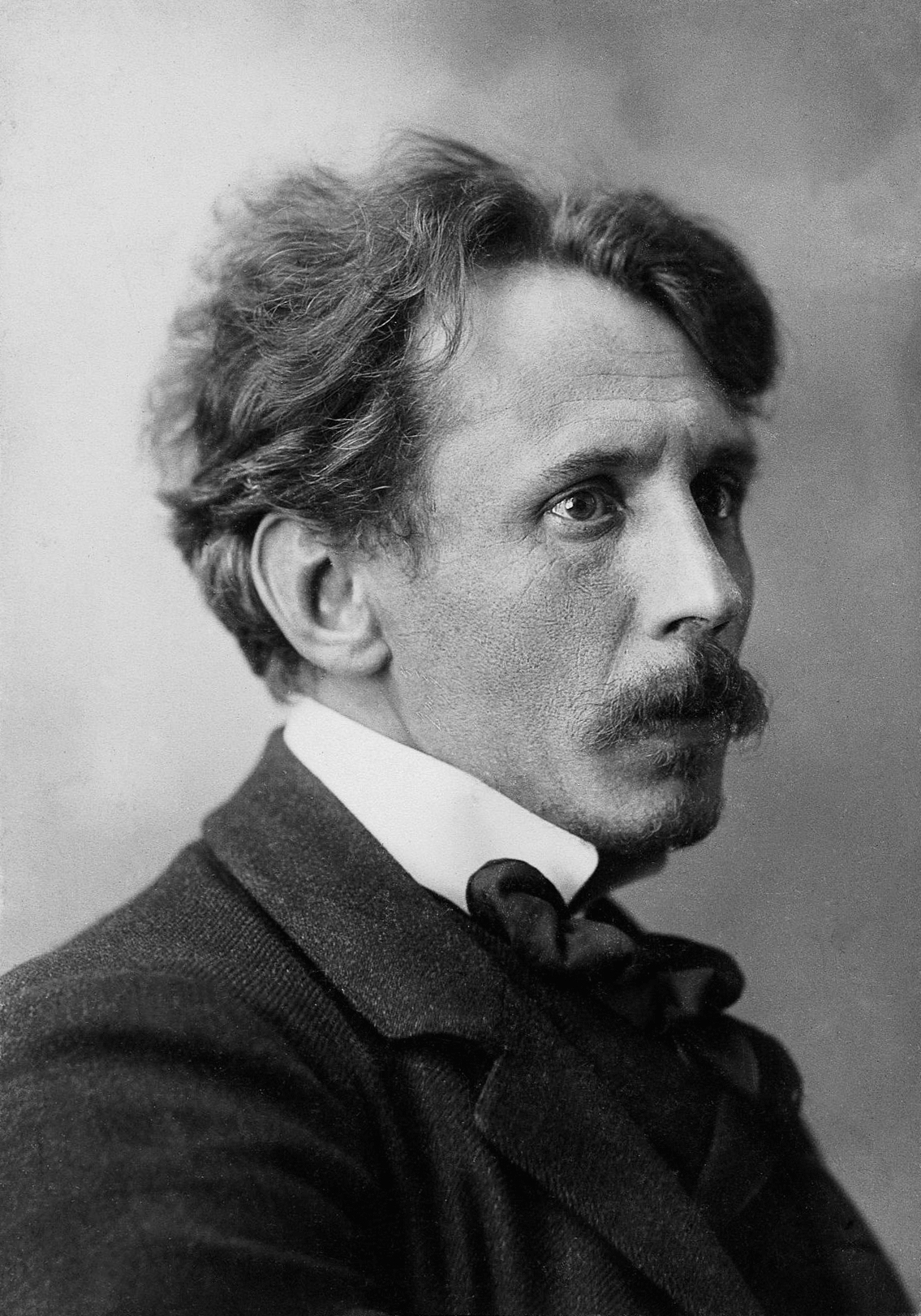
Here, according to a letter by Stasys Čiurlionis (30 X / 12 X 1901), they used to go painting and rowing in Nemunas.

Čiurlionis gave the painting "Christ" to A. Prapiesčius, an inhabitant of Lipliūnai village.

Čiurlionis and his brothers sailed to Kaimelis in the Jurbarkas district carrying the painting "Saint Roch", which had been commissioned by the priest of Kaimelis.

Since 2013, Vilnius and Palanga have been hosting the International M. K. Čiurlionis Music Festival in July, which annually presents the most prominent personalities of the world of music from the USA, France, Germany, Israel and other countries, choirs, orchestras, ballet, concert programmes of the winners of the International M. K. Čiurlionis Competition, winners of the Lithuanian National Prize, the most famous Lithuanian expatriates and more. In Palanga, performers give concerts in the Kurhaus Hall, Birutė Park Rotunda and Tiškevičius Palace. The festival opens in Palanga on 6 July with a concert on the terrace of Tiškevičius Palace.
Čiurlionis' name is also commemorated in the Palace's Rose Walk, where a rose dedicated to Čiurlionis was planted.
More information: www.ciurlioniokelias.lt

In July 1908, M. K. Čiurlionis and his fiancée Sofija Kymantaitė spent the month of July in Palanga (she was staying at the house of S. and A. Bugailos). M. K. Čiurlionis lived near Birutė Park. It is likely that the route of the couple's walks led both to the park and to the palace and Birutė Hill.
More information: www.ciurlioniokelias.lt

In 1981, a sculpture "Sagittarius" by Steponas Šarapovas (1936-1981) was erected on the Youth Hill in Birutė Park (then Botanical Park) in Palanga (in the northern part of the park, to the right of the central entrance to the park, near Darius and Girėnas Street). The decorative monument is based on the painting "The Sun Passes by the Sign of the Sagittarius" (1906/1907) by Mikalojus Konstantinas Čiurlionas, part of the 12-painting cycle "Zodiac". On 11 December 1984, the sculpture was declared an art monument. In 1993, the sculpture was entered into the Register of Real Cultural Property (unique number - 15334).
More information: www.ciurlioniokelias.lt

The house of S. and A. Bugailos, where Sofija Kymantaitė visited in 1898-1899, was built in 1898. Marija Bugailaitė (Pocevičienė), the daughter of S. and A. Bugailos, and Sofija were friends. Kymantaitė returned to this house in 1908, when she was already engaged to M. K. Čiurlionis. M.K. Čiurlionis also visited her here.
On 21 September 1969, a commemorative plaque created by Dalia Zubovaitė-Palukaitienė (the granddaughter of M. K. Čiurlionis and S. Kymantaitė-Čiurlionienė) was added to house.
More information: www.ciurlioniokelias.lt

At the turn of the 19th and 20th centuries, the Mykolas Oginskis Orchestra used to play in the summer in the open rotunda in the park near the Kurhaus, which was created by the Tiškevičius. Mikalojus Konstantinas Čiurlionis, who studied to play various musical instruments at Mykolas Oginskis' private school in 1889-1893, was also a flutist in the orchestra. Unfortunately, the wooden rotunda of the park has not survived to this day.
More information: www.ciurlioniokelias.lt
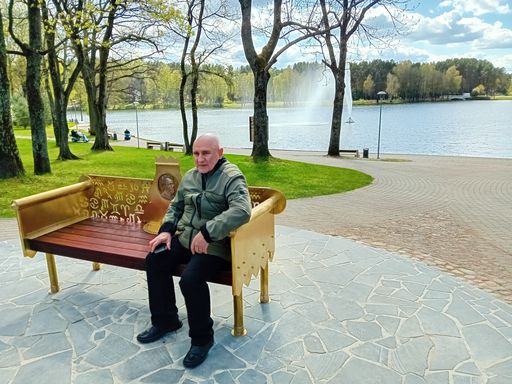
15th April, 2024 a bench, dedicated to M.K. Čiurlionis was opened to the public in Druskininkai, next to Druskonis lake.
Photograph belongs to Druskininkai City Museum and Gallery. In the photo sits the author of the bench - Romualdas Inčirauskas.

The bridge to the sea in Palanga (at the end of J. Basanavičiaus St.), funded by the Counts Tiškevičius, was built in 1882 (reconstructed in 1998). It was a favourite place for the fiancés Sofija Kymantaitė and M. K. Čiurlionis, who came here in 1908 for a walk and a summer holiday.
More information: www.ciurlioniokelias.lt

2018 m. A monument to the artist, "Lengend. Kings" (sculptor D. Matulaitė, architect J. Balkevičius).
The monument, made of green granite and full of Čiurlionian symbols, is based on one of Čiurlionis's most famous paintings, "The Fairytale (The Fairytale Tale of the Kings)" (created in 1909 during a visit to his wife Sofija's uncle, Pastor Vincentas Jarulaitis, in the old Plungė parsonage).
More information: www.ciurlioniokelias.lt

As Leonas Daumantas, the cook of the manor, told, M.K. Čiurlionis loved to be in nature: he was particularly fond of the park of the manor, its ponds with turtles, and the pheasantry with the pheasants and the tame roe deer that came running in at the time of their feeding. Čiurlionis loved to admire the feathers of the pheasants and pat the back of the deer when it came running.
When Čiurlionis left Plungė (1894), the pheasant keeper Andžejus Kotoviakas came to see him off with a beautiful live escort of pheasants, peacocks and a tame doe.
This place of the park was not forgotten in later years when M. K. Čiurlionis, already married to Sofija, stayed with her uncle, priest Vincentas Jarulaitis, in the parsonage (1909), and every day, while taking a walk in the surroundings of Plungė, in the park, they would also pass by the former pheasant house (which had already been dismantled in 1909).
More information: www.ciurlioniokelias.lt

The Mykolas Oginskis Manor was famous not only for its treasures (portraits, sculptures and other works of art), but also for its cultural environment and the development of culture. He also funded the St. John the Baptist Church in Plungė, the publishing of Lithuanian books and the first Lithuanian play. It was in this cultural environment that M. K. Čiurlionis, who came from Druskininkai in 1899 to study music, found himself.
The palace is now home to the Samogitian Art Museum, where we can also find exhibits related to Čiurlionis that shed light on the artist's life and work in Plungė. One of the rarer exhibits is the "C. BECHSTEIN": a product of the Carl Bechstein (1826-1900) piano and piano factory, made around 1870. It was played not only by Pranas Dovydavičius, the leader of the Oginski Orchestra, but also by M. K. Čiurlionis, a talented pupil of the Music School.
More information: www.ciurlioniokelias.lt

Since 2006, on the initiative of the Plungė Mykolas Oginskis Art School, the International Mykolas Oginskis Festival has been held annually in the former horse stable of the Duke M. Oginskis Manor, one day of which is dedicated to the memory of M. K. Čiurlionis. On that day, a concert of youth orchestras "Autumn Watercolour for M.K. Čiurlionis" takes place, when the Joint String Orchestra of the Music and Art Schools of the Samogitian Region (over 160 young performers) rings out powerful chords.
More information: www.ciurlioniokelias.lt

Mykolas Oginskis established a music (orchestra) school in Plungė Manor (now the Samogitian Art Museum) around 1873 and formed an orchestra of 35-50 musicians. Young people from all over Lithuania and further afield came to the school: there were students from Riga, Warsaw, Perm, Grodno. The institution quickly gained a reputation as a professional school, training professional musicians and having an orchestra at the level of Western Europe. Mykolas Oginskis Manor Orchestra School in Plungė was attended by M. K. Čiurlionis (14 years old) from 1889 to 1893 with the support of his family friend, Juozas Markevičius. From 1892 onwards, as a flutist in the orchestra, he received not only housing and a uniform, but also a salary (5 roubles).
According to the memoirs of Adolfas Daumantas, a tailor at the manor, Kastukas admired not so much the musician's uniform itself, but the two lyres sewn into the collar of his jacket. Touching them with his fingers, he smiled and said, "Now I am a real musician."
The orchestra simply overwhelmed the young musician - he studied the scores of each instrument, analysed them, compaed them. Seeing a young man with exceptional musical talents, the leader of the orchestra not only played a high-class C. Bechstein concert grand piano himself, but also allowed the young musician to improvise with it.
Since the music school has not survived to the present day, a decorative roof was erected on the site of the "Muzikantine" in 1990 by the folk masters J. Majoras and J. Šakinis. The carved lyre in the roof is an ancient Greek stringed instrument, a symbol of poetic creativity and inspiration, and a symbol of the Plungė Orchestra (it was also present in the uniforms). In the roof pillar, above the lyre, three brushes and a violin key are carved, thus commemorating the beginning of M. K. Čiurlionis' creative path in Plungė.
More information: www.ciurlioniokelias.lt

In June-September 1909, Sofija Kymantaitė-Čiurlionienė and M. K. Čiurlionis came to Plungė for the second time and stayed in the parsonage in two small rooms. According to Čiurlionis, the huge salon became his workshop. This is the time of the artist's mature work, when more than 20 paintings were born, including "Waycrosses of Samogitia", "Fairytale (Fairytale of the Kings)", "Fairytale (Fairytale of the Castle)", "Angels", "Altar".
In 1975, on the occasion of the centenary of the artist's birth, roof pillars were erected in the courtyard of the parsonage based on the painting by M. K. Čiurlionis "Waycrosses of Samogitia" (created by folk artists Liudas Ruginis, Vaclovas Banevičius and Vytautas Bytautas). In the same year, a memorial plaque with a bas-relief of the couple, created by sculptor Vytautas Juzikėnas, was unveiled on the wall of the old parsonage in Plungė.
More information: www.ciurlioniokelias.lt

In the old wooden church of St. John the Baptist Church (demolished in 1934 when a new church was built nearby), M. K. Čiurlionis used to play and sing. He sang in the church choir, together with other pupils of the manor's orchestra school. In the summer of 1909, when M. K. Čiurlionis was visiting his wife Sofija Kymantaitė with her uncle, priest Vincentas Jarulaitis, he would often play the organs during Sunday Mass.
More information: www.ciurlioniokelias.lt

In Karklėnai, Elžbieta Kymantienė, Sofija's mother, in order to improve her financial situation, rented the Leliūgai farm for seven years and tried to farm there. In her spare time, Sofija's father, Leonas Kymantas, also helped out.
The homestead, which did not survive, belonged to Jonas Leliūga, who left with his family in 1907 to seek happiness in America, leaving behind his mother Klara. Her memory of the time when Sofija and Konstantinas visited the homestead has been preserved down to the last detail. Eleonora Ravickienė described them in her book "On the Trails of Centuries".
The beautiful surroundings of Karklėnai inspired the young artists, and the local people often saw them happily wandering around Karklėnai, along the picturesque cliffs of the Vieštovė river. Čiurlionis often wandered as far as the plague cemetery, surrounded by the tranquillity of oak trees. This place left a deep impression on the artist, recognisable in his 1909 painting "Žemaičiai kaplytpulpiai" ("Samogitian Chapels").
More information: www.ciurlioniokelias.lt

The orchestra of the Duke M. Oginski Manor, in which M. K. Čiurlionis played, often gave concerts at the foot of the Gandinga mounds.
More information: www.ciurlioniokelias.lt

In 1862-1875, Count Pliateriai founded the construction of the present neo-Gothic brick church of St. Mark the Evangelist in the place of the wooden church, designed by the architect Tomas Tišeckis. On 1 January 1909, priest Vincentas Jarulaitis married the composer and painter Mikalojus Konstantinas Čiurlionis and his niece, the writer Sofija Kymantaitė-Čiurlionienė. The place chosen was more secluded, but evoked pleasant memories for both young people (Sofija Kymantaitė-Čiurlionienė wrote in her letters that she wanted to marry in a quiet place, although she had been offered to marry in Plungė).
More information: www.ciurlioniokelias.lt

Sofija Kymantaitė (1886-1958) was born into a family of landless nobility in Joniškis. When the Kymantai family received an offer from Sofija's mother's brother, pastor Vincent Jarulaitis, to come and work on his farm to improve their financial situation, the family agreed. In 1893, when the girl was 7 years old, they all moved to Kuli, where the girl began her education with the help of her uncle. Here she picked up the Samogitian dialect and style.
In 1898, while attending Palanga elementary school for girls, she returned to Kuliai and met a young priest, Juozas Tumas-Vaižgantas, who had recently arrived there and who diligently taught everyone to read and write Lithuanian, including Sofija Kymantaitė. It was Juozas Tumas-Vaižgantas who took Sofija to the first Lithuanian play in Palanga in 1899. With her uncle financing her, S. Kymantaitė continued her studies in St. Petersburg's St. Catherine gymnasium, and in 1904 finished the gymnasium in Riga. In 1904-1907, she studied at the Baranecki Courses and the University of Cracow, and later philosophy and literature.
In 1909, M. K. Čiurlionis visited Kuliai with Sofija. Together they visited Sofia's parents.
More information: www.ciurlioniokelias.lt
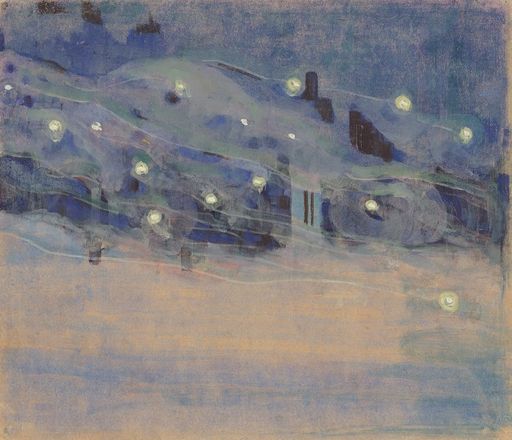
Museum Belvédère is the first museum in the Netherlands to dedicate an exhibition to the work of Mikalojus Konstantinas Čiurlionis (1875-1911). Čiurlionis is Lithuania's most important composer and visual artist. Art historians compare him to contemporaries such as Gustav Klimt, Edvard Munch and Wassily Kandinsky.
Although the work of Čiurlionis (1875-1911) remained virtually unknown in the west during the years when Lithuania was part of the Soviet Union, many major museums around the world have devoted exhibitions to him in recent decades. In 2024, Museum Belvédère will offer this unique double talent a stage in the Netherlands. The emphasis of the exhibition is on Čiurlionis' later works, painted with tempera paint, in which he finds a symbiosis between visual art and music in his own symbolist style.
Beyond Heaven and Earth
At the beginning of the last century, Čiurlionis developed his own symbolic style, drawing on Lithuanian sagas, myths, fairy tales and folk beliefs as well as non-Western cultures, ranging from Ancient Egyptian, Indian to Asian. Using the drawing as a basis, Čiurlionis made many tempera paintings in which secrets are evoked and the earthly world is connected to the supernatural.
Instead of reality – as we (re)know it – he depicted a different world with his work. This depiction of unprecedented images and worlds is a common thread through his work. He was never concerned with abstractions, but with the mentally imaginable.
More information: https://www.museumbelvedere.nl/en/current/grote-zaal/

M. K. Čiurlionis' patron Mykolas Oginskis, the Duke of Plungė, his brother Duke Bogdan Oginskis, their mother Olga Oginskienė and several other unidentified members of the family are buried in the Oginskis' mausoleum in the chapel of the Dawn Gate in Rietavas. After the death of Mykolas Oginskis, Čiurlionis's education was threatened: the death of his patron led to the termination of the artist's funding.
More information: www.ciurlioniokelias.lt
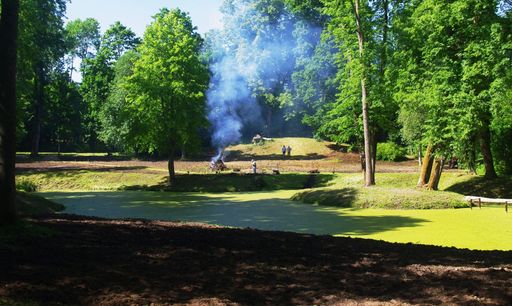
The romantic and legendary Love Hill is located in the north-west quarter of Rietavas Park. It is also known as the hill of orchestrators. Because the musicians of the Bogdan Oginski and Michael Oginski orchestras loved to play music and have fun on its southern slope. M. K. Čiurlionis was also among them in 1890-1892.
At the foot of the hill, the pond of Love's Tears is a reminder of how many tears the ladies of the manor once shed here in longing for their chosen ones.

Much of the Oginskis' residence was left in a state of disrepair, leaving only a shadow of its former splendour. It was not until the Lithuanian Revival, as part of the 100th anniversary program of the first public power station in Lithuania, that the portico colonnade and the ornate parterre lights were restored in 1992, and the foundations were partially conserved. In 2015, on the occasion of the 250th anniversary of Mykolas Kleopas Oginskis' death, a monument created by sculptor Regimantas Midvikis was erected in front of the colonnade, with a joint dedication to the memory of the Dukes' Oginskis' bright family. The name of M. K. Čiurlionis' patron, Mykolas Oginskis, is also inscribed here.
More information: www.ciurlioniokelias.lt

In 1848-1894, the Rietavas Manor, under the management of Irenėjus Oginskis, was the site of an 83-hectare park and the richest conservatory (orangery) in the Baltic States at that time, where palm trees and a number of other subtropical plants were grown. At the foot of the impressive conservatory complex, a spacious musicians' terrace was built, where the Rietavas and Plungė orchestras, including the flute-playing M. K. Čiurlionis, performed. Those who played could admire the panoramic views of the Oginskis' residence and the park's approach with the mirrors of the Leliai and Malūnas ponds to the south. Behind them, you could see the walls of the central part of the city and the glittering silhouettes of the towers of St Michael the Archangel Church.
At the beginning of the 20th century, the Musicians' Terrace deteriorated as the musical traditions of Rietavas died out. Now, the preservation of the Musicians' Terrace has been taken up by the preservationists of Rietavas' cultural heritage.
More information: www.ciurlioniokelias.lt
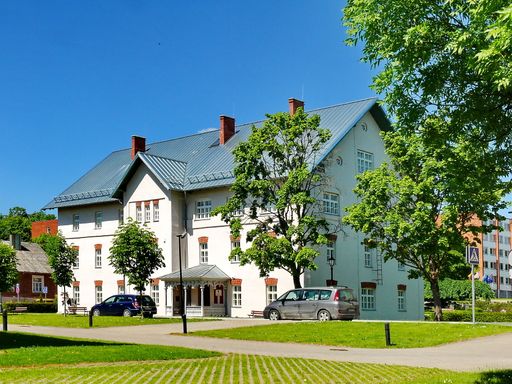
In 1872, Bogdan Oginski founded a six-year music school in Rietavas, which operated until 1909.The school building was not only home to students and orchestra musicians, but also to musicians of Mykolas Oginskis' Plungė Orchestra who came to perform. Among them was Mikalojus Konstantinas Čiurlionis, who studied at the Plungė Music School in 1889-1893.
More information: www.ciurlioniokelias.lt

The building, which has housed the Rietavas Cultural Centre and the Rietavas Tourism and Business Information Centre since 2014, was formerly the Rietavas Manor Carriage House. Next to it, after passing the White Gate, musicians from the Mykolas Oginskis Orchestra, including the orchestra's flutist M.K. Čiurlionis, would stop to celebrate joint events.
Since 2018, the concert halls of the Culture Centre have also been presenting the events of the M. K. Čiurlionis Cultural Route as a tradition.
More information: www.ciurlioniokelias.lt

Rietavas Manor has seven ponds, which were dug at the request of the noble Oginskis. The largest pond is Malūno (Mill Pond), which has four islands that were once admired by M. K. Čiurlionis, who played in the manor orchestra. The largest island, Musicians (Muzikantu), was the venue for farewell concerts for musicians from Rietavas and Plungė, where M. K. Čiurlionis played the flute.
Looking from the Red Gate Avenue, the silhouettes of the pond islands are reminiscent of the contours of Čiurlionis' painting "Serenity" (1904/5). One of the islands was named "Serenity" in honor of the painting. The other islands were given the names "Evening" and "Altar" by the cultural heritage preservationists of Rietavas.
More information: www.ciurlioniokelias.lt

In 1852, after completing the reconstruction of the Rietavas manor house and the town, Prince Irenejus Oginskis started to organise the construction of the new church. The impressive neo-Romanesque temple was designed by the architect of the Prussian royal court, Friedrich August Stiuler.
On 9 June 1853, the cornerstone was consecrated by the Bishop of Samogitia, Motiejus Valančius, and the major construction work began, which lasted for more than 20 years. The pride of Rietavas is the historic 100-bulb chandelier of the church, where electric light shone for the first time on Easter morning on 17 April 1892. During this ceremony, M. K. Čiurlionis played in Rietavas and Plungė joint orchestra.
More information: www.ciurlioniokelias.lt

In 1940, Stonkai, who had purchased the painting "News", left for Samogitia, handing over the work of Čiurlionis to Antanas and Birutė Navickas for protection, who lived in Kaunas at the time in Vaičaičio Street No.4. The Navickas family left Lithuania in the same year, and the painting was left in their apartment. Here, on 8 February 1972, the paintings were found left behind. Čiurlionytė-Karužienė found the painting still hanging in the Navickas' possession, and it was later handed over to the National M. K. Čiurlionis Art Museum.

During World War II (from 1942 until the flooding of the Nemunas River in 1946), a part of M. K. Čiurlionis's paintings was kept in the vault of the Bank of Lithuania. Some of the paintings were damaged by the flood.

The building (former Adamčikas progymnasium), where the first Lithuanian art exhibition in Kaunas took place in 1908, was located near the current Kaunas City Hall (Laisvės al. 96).
The first exhibition in Kaunas was a continuation of the Second Lithuanian Art Exhibition in Vilnius, which was organised by M. K. Čiurlionis, who served as vice-chairman of the Lithuanian Art Society. After this exhibition, MKČ donated his painting "The Past" to the museum owner Tadas Daugirdas.

Purchased from Sofija Kymantaitė, M. K. Čiurlionis artworks were house here between 1922-1923 until the M. K. Čiurlionis Gallery was built. Complaints about the storage space have survived: in the daily newspaper "Lietuva" of 6 February 1923, there is a complaint by Vytautas Pranas Bičiūnas, a member of the Parliament at the time, that the building's humidity and the fire risk of the surrounding buildings were endangering the legacy of M. K. Čiurlionis. The paintings later were moved to headquarters of Ministry of Education.

The Temporary M. K. Čiurlionis Art Gallery (now the J. Vienožinskis Faculty of Arts of Kaunas College, Owl Hill) is the beginning of the history of the current National M. K. Čiurlionis Art Museum. On 14 December 1921, Aleksandras Stulginskis, the chairman of the Lithuanian Constituent Seimas, who was also the President of the Republic, promulgated the "Law on the Gallery in the Name of M. K. Čiurlionis", which established a gallery to preserve the artistic treasures of Lithuania, including the artistic legacy of M. K. Čiurlionis. In 1922, on the basis of this law, the Ministry of Education bought all the works of M. K. Čiurlionis (193 pieces) in the possession of Sofija Čiurlionienė for 65,000 German gold marks, which became the basis for the National M. K. Čiurlionis Museum of Arts.
Even though the Gallery was opened for 5 days in September (1925) to celebrate the 50th birthday of M. K. Čiurlionis, the official opening day was on 13 December 1925. However, not everyone was happy with the location - in 1927 there were complaints that the gallery was too far from the centre, did not have enough space for all of the art works, and so in 1936 the gallery was transformed into the Vytautas the Great Museum of Culture and moved to a new building at 55 Putvinskio Street.

In 1908, Čiurlionis had to travel by train to the Second Lithuanian art exhibition (which was moved from Vilnius) in Kaunas (held in Adamčikas Pro-Gymnasium, which has not been preserved), and hence through one of the oldest railway tunnels in Europe, which was completed in 1861.

In 1908, M. K. Čiurlionis and Sofija Kymantaitė admired the panorama of the city and the Nemunas River at the Aleksotas observation deck (during the Second Exhibition of Lithuanian Art, which took place at the Adamčikas Pro-Gymnasium (non-existant)).

In 1975, the sculpture "Čiurlionis" by sculptor A. Kazlauskas was erected in the square next to the Varėna railway station to commemorate the 100th anniversary of the birth of M. K. Čiurlionis.
More information: www.ciurlioniokelias.lt

Varėna railway station was built in 1862 after the construction of the Petersburg - Warsaw railway. From it, M.K. Čiurlionis travelled many times between 1889 and 1911 in the directions of Vilnius, Warsaw and St Petersburg. From there, he used to return home to Druskininkai by carriage.
The railway station was restored in 2012.
More information: www.ciurlioniokelias.lt

Established in 2011, the Varėna Legends Park is a place where you can get acquainted with the legends of the region that inspired M. K. Čiurlionis. The park has 7 benches inspired by nature and 9 wooden sculptures inspired by the legends of the Varėna region. The park has a mini-stage where evening music concerts, folklore and other events are held in an unconventional space.
More information: www.ciurlioniokelias.lt

Next to the road and the bridge over the Merkys river leading from Old Varėna to Varėna is an ensemble of 7 oak sculptures, one of which is dedicated to M. K. Čiurlionis. J. Videika's sculpture "The Birth of Čiurlionis" depicts the land of Varėna raising a child playing with a dandelion seedhead (reminiscent of the second part of the triptych "Fairy Tale"), accompanied by Čiurlionis' often used bird images. The ensemble also includes R. Gudliauskas's sculpture "Woods Guardian", A. Lastauskas's "Lithuanian Bard with a Kanklės", E. Motiejutis's "Vytautas with Falcons", P. Malinauskas's "Varėnė" and A. Juškevičius's "Confluence of Rivers". The sculpture ensemble is completed by the sculpture of K. Žlabis "The Railwayman", dedicated to the railway St Petersburg - Warsaw, thanks to which the town of Varėna grew. This railroad was also used by M. K. Čiurlionis. The sculptures were decorated with wrought metal daisies by St. Truncė.
More information: www.ciurlioniokelias.lt

The memorial "Angel", created by sculptor Mantas Paulauskas, was erected in 2015 in Vytautas Street, in front of the St Michael the Archangel Church. The sculpture was inspired by M. K. Čiurlionis' painting "The Offering" (1909).
More information: www.ciurlioniokelias.lt

Around 1776, the first church was built in Old Varėna, funded by the State Chancellor Mykolas Bžostovskis. In 1874, Konstantinas Čiurlionis and his wife Adelė came to Old Varėna from Liškiava to work as organists. In the autumn of the following year (22 September 1875 (10 according to the old calendar)) their first son was born. The first child was baptised Mikalojus Konstantinas on 1st October by the priest Aloyzas Giaras in the St. Michael the Archangel Church.
The church was destroyed during World War I. In 1994, a new church was built on the same site according to a design by architects Bruno Bakaitis and Gediminas Baravykas. The new church uses forms and rhythms similar to the work of M.K. Čiurlionis, for example the bell tower of the sanctuary is reminiscent of the bell tower of the painting "Spring" (1907). The very fact of Čiurlionis' baptism is commemorated in a commemorative plaque (by Mantas Paulauskas) and stained glass windows (by Vytautas Švarlys).
Every year, in cooperation with the Lithuanian Musicians' Support Foundation, the Church of St. Michael the Archangel organizes the musical program "The Way of M. K. Čiurlionis", which starts and takes place during the festival "Druskininkai Summer with M. K. Čiurlionis".
More information: www.ciurlioniokelias.lt

"M. K. Čiurlionis Road" is an ensemble of wood sculptures created in 1975-1976 by masters of folk art to mark the 100th anniversary of M. K. Čiurlionis' birth. The 25 works (wooden sculptures and roofed poles) decorate the road from Old Varėna to Druskininkai (A4 Vilnius-Varėna-Gardinas road).
In the 1st group of compositions in Old Varėna there is the sculpture "Čiurlionis" by I. Užkurnis and "The Birth of Čiurlionis" by A. Gedvilas - a two-story sculpture with figural bas-reliefs on the 1st floor eaves and an iron sun of plant forms forged by the blacksmith J. Praninskas; the bas-reliefs were painted by M. Bičiūnienė. Both compositions are enclosed by a fence. On the fence there is a painting by B. Dabrukas' decorative plaque with the names of the creators of the road ensemble.
More information: www.ciurlioniokelias.lt

"M. K. Čiurlionis Road" is an ensemble of wood sculptures created in 1975-1976 by masters of folk art to mark the 100th anniversary of M. K. Čiurlionis' birth. The 25 works (wooden sculptures and roofed poles) decorate the road from Old Varėna to Druskininkai (A4 Vilnius-Varėna-Gardinas road).
St. Karanauskas' sculpture "Grass Snake Žilvinas" depicts a serpent with an iron crown emerging vertically from the water (blacksmith V. Jarutis).
More information: www.ciurlioniokelias.lt

"M. K. Čiurlionis Road" is an ensemble of wood sculptures created in 1975-1976 by masters of folk art to mark the 100th anniversary of M. K. Čiurlionis' birth. The 25 works (wooden sculptures and roofed poles) decorate the road from Old Varėna to Druskininkai (A4 Vilnius-Varėna-Gardinas road).
The second group of compositions on the M. K. Čiurlionis Road - two works between Old Varėna and Perloja. J. Grabauskas's composition "Rhythms of Music" is a massive column surrounded by a bas-relief of various musical instruments, with a metal oak leaf crown. The sculpture "Decorative Obelisk" by K. Krapauskas and V. Jarutis (blacksmith) is decorated with rosettes in the middle and covered with a four-sided roof.
More information: www.ciurlioniokelias.lt

"M. K. Čiurlionis Road" is an ensemble of wood sculptures created in 1975-1976 by masters of folk art to mark the 100th anniversary of M. K. Čiurlionis' birth. The 25 works (wooden sculptures and roofed poles) decorate the road from Old Varėna to Druskininkai (A4 Vilnius-Varėna-Gardinas road).
The III group of compositions on the M. K. Čiurlionis Road consists of two sculptures between Perloja and Merkinė - near the village of Milioniškiai. These are "The Bellringer" by I. Užkurnis (the figure of a bell-ringer in profile at the bottom, with a bell above him). Another sculpture is "Run, Barrels" by R. Kilis, based on a Lithuanian folk song. The reliefs of the sculpture were painted by M. Bičiūnienė.
More information: www.ciurlioniokelias.lt

"M. K. Čiurlionis Road" is an ensemble of wood sculptures created in 1975-1976 by masters of folk art to mark the 100th anniversary of M. K. Čiurlionis' birth. The 25 works (wooden sculptures and roofed poles) decorate the road from Old Varėna to Druskininkai (A4 Vilnius-Varėna-Gardinas road).
P. Dužinskas' "Celebration" stands near the village of Purpliai (between Perloja and Merkinė). The thick column is carved with 2 large, detailed friezes with figures of musicians (lower) and singers (upper) and words of harmonised Lithuanian folk songs by M. K. Čiurlionis. The cross rood is with an iron sun by J. Praninskas.
More information: www.ciurlioniokelias.lt

"M. K. Čiurlionis Road" is an ensemble of wood sculptures created in 1975-1976 by masters of folk art to mark the 100th anniversary of M. K. Čiurlionis' birth. The 25 works (wooden sculptures and roofed poles) decorate the road from Old Varėna to Druskininkai (A4 Vilnius-Varėna-Gardinas road).
A group of compositions (three sculptures and a bench) from M.K. Čiurlionis Road IV Group is located at Merkinė on the Varėna-Merkinė road. The sculpture 'Mąstytojas' by A. Valuckis has geometric forms, with reliefs of faces and ornamental bands, and is covered by a cross-shaped roof. The roofed pole "Bell Tower" by V. Savickis is surmounted by moving, angular bells, with a weathervane by P. Raudis above the wide cross roof. St. Karanauskas' sculpture "Four Kings" features a bas-relief composition with allegorical content and a figure of Čiurlionis, with a frieze of arches and a conical roof with carved daisies above it. The massive K. Nemanis' bench has M. K. Čiurlionis words carved out.
More information: www.ciurlioniokelias.lt

"M. K. Čiurlionis Road" is an ensemble of wood sculptures created in 1975-1976 by masters of folk art to mark the 100th anniversary of M. K. Čiurlionis' birth. The 25 works (wooden sculptures and roofed poles) decorate the road from Old Varėna to Druskininkai (A4 Vilnius-Varėna-Gardinas road).
V. Ulevičius' "Čiurlionis-Sagittarius", which stands near the village of Česukai, has a bas-relief composition carved into the torso of the roofed pole (Čiurlionis aiming a bow at a dragon). The pole's roof is extended by an ornamental frame structure and a three-pointed star top by V. Jarutis.
More information: www.ciurlioniokelias.lt

"M. K. Čiurlionis Road" is an ensemble of wood sculptures created in 1975-1976 by masters of folk art to mark the 100th anniversary of M. K. Čiurlionis' birth. The 25 works (wooden sculptures and roofed poles) decorate the road from Old Varėna to Druskininkai (A4 Vilnius-Varėna-Gardinas road).
I. Užkurnis "Girl from Dzūkija Playing Kanklės" (standing near the village of Noruliai) - a carved figure of a kanklės (Lithuanian plucking instrument) musician. On the sides there are shutters made by J. Jucius and painted by M. Bičiūnienė, and on the top there is a gabled roof with an open-work wreath of tutelage carved by J. Ambrazevičius.
More information: www.ciurlioniokelias.lt

"M. K. Čiurlionis Road" is an ensemble of wood sculptures created in 1975-1976 by masters of folk art to mark the 100th anniversary of M. K. Čiurlionis' birth. The 25 works (wooden sculptures and roofed poles) decorate the road from Old Varėna to Druskininkai (A4 Vilnius-Varėna-Gardinas road).
The "Seasons of the Year" roofed pole by J. Paulauskas (located near Utieka village) is almost a two-story sculpture of traditional forms: the first floor roof has primitive sculptures depicting the work of the seasons painted by M. Bičiūnienė, while the top of the upper roof is a peak of plant forms by P. Raudis.
More information: www.ciurlioniokelias.lt

"M. K. Čiurlionis Road" is an ensemble of wood sculptures created in 1975-1976 by masters of folk art to mark the 100th anniversary of M. K. Čiurlionis' birth. The 25 works (wooden sculptures and roofed poles) decorate the road from Old Varėna to Druskininkai (A4 VIlnius-Varėna-Gardinas road).
Close to Randamonys, on the territory of the Druskininkai municipality, there is a sculpture by Stasys Karanauskas, depicting musicians playing various instruments on four sides. The blacksmith Jonas Praninskas added a metal wreath of oak leaves to the sculpture. Painting by Monika Bičiūnienė.
More information: www.ciurlioniokelias.lt

"M. K. Čiurlionis Road" is an ensemble of wooden sculptures created in 1975-1976 by masters of folk art to mark the 100th anniversary of M. K. Čiurlionis' birth. The 25 works (wooden sculptures and roofed poles) decorate the road from Old Varėna to Druskininkai (A4 Vilnius-Varėna-Gardinas road).
The composition of the M.K. Čiurlionis Road V includes the roofed pole "Čiurlionis Monogram" by Vytautas Jarutis, as well as Stanislovas Riauba's sculpture "The Artist", and Justinas Jonušas' sculpture "Sun". Painting by Monika Bičiūnienė.
More information: www.ciurlioniokelias.lt

"M. K. Čiurlionis Road" is an ensemble of wooden sculptures created in 1975-1976 by masters of folk art to mark the 100th anniversary of M. K. Čiurlionis' birth. The 25 works (wooden sculptures and roofed pole) decorate the road from Old Varėna to Druskininkai (A4 Vilnius-Varėna-Gardinas road).
The monumental sculpture "Violinist" on the M. K. Čiurlionis Road, located in the village of Neravai in the territory of Druskininkai Municipality, was created by Vincas Markaitis. The front part of the sculpture has a carved figure of a woman playing the violin.
More information: www.ciurlioniokelias.lt

"M. K. Čiurlionis Road" is an ensemble of wooden sculptures created in 1975-1976 by masters of folk art to mark the 100th anniversary of M. K. Čiurlionis' birth. The 25 works (wooden sculptures and roofed poles) decorate the road from Old Varėna to Druskininkai (A4 Vilnius-Varėna-Gardinas road).
The VI exposition of the "M.K. Čiurlionis Road" consists of the sculptures "Melodies of the Forest" by Jonas Ignotas and the blacksmith Vytautas Jarutis, "For Those Protecting the Forest" by Adelbertas Nedzelskis, and the "Signs of the Zodiac" by Bronis Gedvilas and the blacksmith Vytautas Jarutis. The first, "Melodies of the Forest", has in the upper part of the sculpture, under the roof, figures of musicians playing various musical instruments carved on all four sides. The 'Zodiac Signs' has all twelve signs of the Zodiac carved out.
More information: www.ciurlioniokelias.lt

In the village of Mizarai lived the Vailionis family, with whom the Čiurlionis family was in contact. M. K. Čiurlionis also liked to take walks here. Jadvyga Čiurlionytė mentions that on summer afternoons, all the Čiurlionis' children used to go to Mizarai to socialize with the Vailionis youth. The eldest son of the Vailionis, Juozas (1868-1950), remembers visiting the Čiurlionis' family regularly: he would bring food (the Čiurlionis lived poorly), gifts, and during that time he was also courting M. K. Čiurlionis' sister Juzė (they did not end up together).
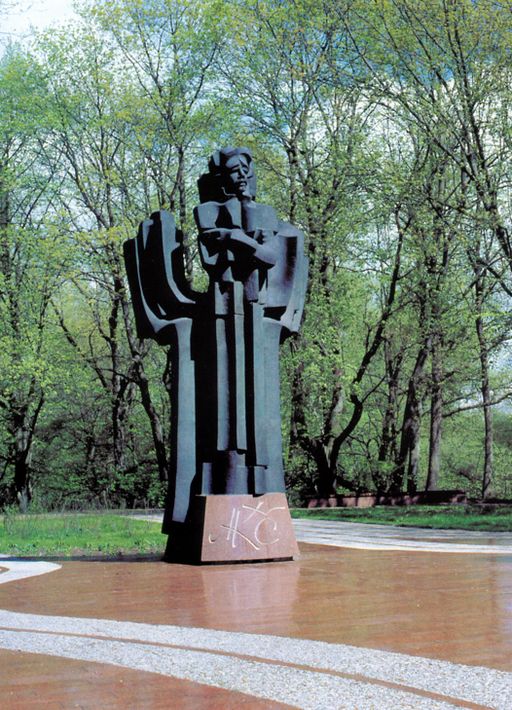
In 1975 Vladas Vildžiūnas (winner of the National Prize of Culture and Art in 1976) created a monument to M. K. Čiurlionis in Druskininkai.
More information: www.ciurlioniokelias.lt

The main street of Druskininkai is named after M. K. Čiurlionis. The sculpture "Sagittarius", inspired by the work of Druskininkai's most famous artist, was erected at the beginning of this street in 2007. The sculpture's author is Vytautas Narutis.
More information: www.ciurlioniokelias.lt
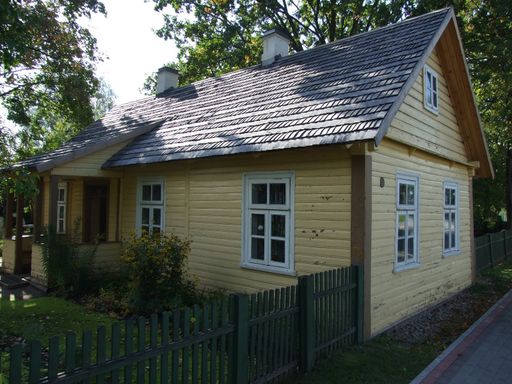
Currently M. K. Čiurlionis House-Museum.
In 1878, the Čiurlionis family moved to Druskininkai. There, the parents have two houses - one closer to the street for summer rentals and one further away, where they live. The Čiurlionis family lives here until World War I, when they flee to Moscow as the front approaches.
In 1963, a memorial museum was opened here (thanks to V. Čiurlionytė - Karužienė) and now it consists of 4 buildings (at the time of the opening it was only 1 house). 2 of them are the Čiurlionis House, where M.K. Čiurlionis lived and worked, restored according to the memories of his sisters. In 1975, an administrative building, the cash desk, was built, where people can learn more about Čiurlionis' work and participate in events. The last building was opened in 1993 - a gallery where reproductions of Čiurlionis' works are exhibited (the originals are exhibited in the National Museum of Art of M.K. Čiurlionis in Kaunas) and where educational activities are held.
More information: www.ciurlioniokelias.lt

Currently Druskininkai City Museum
There are historical testimonies that M. K. Čiurlionis used to come to the villa "Linksma" to give piano lessons to his youthful friend, the villa owner's youngest daughter, Gražina Kiersnovskytė, and to paint nature with her sister, Zofija Kiersnovskyte.
More information: www.ciurlioniokelias.lt

M. K. Čiurlionis' parents (Adelė Marija (1853-1919) and Konstantinas (1846-1914) Čiurlionis) and his sister Jadvyga (1898-1992) are buried in the Old Cemetery in Druskininkai.
The candlelit procession leading to this cemetery may have inspired M. K. Čiurlionis to paint the Funeral Symphony.
More information: www.ciurlioniokelias.lt

Stained glass windows with the image of M. K. Čiurlionis hang in the M. K. Čiurlionis Art School in Druskininkai. Since 2015, new stained glass windows have been created during the stained glass symposium "Reflections of Čiurlionis". The symposium is organised by the Druskininkai City Museum, which annually invites four professional stained glass artists, members of the Lithuanian Artists' Union, who stay for five days in a creative camp in Druskininkai to create sketches for stained glass windows for the interior of the Druskininkai M. K. Čiurlionis Art School. The selected stained glass windows later decorate the interior of the school.
More information: www.ciurlioniokelias.lt

Unveiled in 2000 to commemorate the 125th anniversary of the birth of M. K. Čiurlionis. Artist Žilvinas Landzbergas.

Opened in 1945 as the Vilnius Ten-Year Music School, in 1965 it was renamed the Vilnius M. K. Čiurlionis Secondary School of Art. In 1994 it was renamed the Vilnius Mikalojus Konstantinas Čiurlionis Arts Gymnasium. In 2001, by Order No 720 of the Minister of Education and Science, the M.K. Čiurlionis Arts Gymnasium and the Vilnius Ballet School were reorganised into the National Mikalojus Konstantinas Čiurlionis School of Art.

The National Art Gallery's first permanent exposition "At the Crossroads of Epochs" is dedicated to the art of the early 20th century, and therefore it pays a lot of attention to the first exhibition of Lithuanian art in 1907, the Lithuanian Art Society, and the Vilnius Art Society, which was established in 1908.
Thus, the works of M. K. Čiurlionis are exhibited alongside the works of other artists who took part in these gatherings and who formed the foundations of modern art at the beginning of the twentieth century, such as Stanislovas Bohusas-Sestšencevičius, Petras Kalpokas, Petras Rimša, Ferdinandas Ruščicas, Kazimieras Stabrauskas, Justinas Vienožinskis, Antanas Žmuidzinavičius.
More information: www.ciurlioniokelias.lt

At the beginning of the summer of 1908, on the last night before leaving Vilnius, M. K. Čiurlionis and his fiancée Sofija Kymantaitė greeted the dawn on the hill of Gediminas Castle Tower.
More information: www.ciurlioniokelias.lt

Polesė (Pagiriai) Railroad Hall – currently the Vaidila Theatre.
In November 1907, in the late 19th century neo-Gothic arc-architectural building (now the Vaidila Theatre), M. K. Čiurlionis attended the dress rehearsal of Gabrielius Landsbergis-Žemkalnis's play "Tadas Blinda", during which he met his future wife, Sofija Kymantaitė. In May 1908, the Vaidila Theatre also hosted the premiere of Čiurlionis' cantata "De Profundis", performed by the male choir of Vilnius Kanklės (the organ part was adapted for piano).
More information: www.ciurlioniokelias.lt

The proposal to build the Nation's House on Tauras Hill was put forward by Dr Jonas Basanavičius, but representatives of various societies also took an active part in the discussion. M. K. Čiurlionis himself, who enthusiastically supported the idea since 1907, also discussed it in his articles.
November 1907, in the 205th issue of "Vilniaus žinios" (Vilnius News), the Committee of the Lithuanian People's House, which consisted of members of the Lithuanian Art Society and the Lithuanian Science Society, addressed the public with a proclamation calling for the establishment of the "Lithuanian Nation's House": for a single building for meetings of various national societies, choir rehearsals, performances, concerts, and exhibitions of Lithuanian art.
More information: www.ciurlioniokelias.lt

In the house at 24 Gedimino Avenue, built in 1860-1914, then the former hall of the Intellectuals' Club, at the beginning of the summer of 1908, M. K. Čiurlionis gave a concert in the evening of the newspaper Aušra's 25th anniversary celebration with the choir of the Vilnius Kanklės and with the tenor Kipras Petrauskas.
More information: www.ciurlioniokelias.lt

The Headquarters of Lithuanian Culture Society „Rūta“ - currently the State Small Theatre of Vilnius
In 1909, the hall in this house was rented by the Lithuanian cultural society "Rūta", for whose stage M. K. Čiurlionis, together with Sofija Kymantaitė, painted the curtain in June of that year. In the same month, the musician gave a concert in this hall, playing the first movement of Ludwig van Beethoven's Sonata (Op. 2 No. 3) and two of his preludes.
More information: www.ciurlioniokelias.lt

The corner house at Gedimino Ave 10 and Totorių St. 1 housed the editorial offices of the newspaper "Vilniaus žinios" and the photography and zincography studio of Aleksandras Jurašaitis.
At the end of 1907 and in January 1908, Čiurlionis wrote announcements to the editorial office about music theory and ringing lessons (in Čiurlionis' rented flat at Savičiaus Street 11 at the time) and rehearsals of the "Vilniaus kanklės", and in June 1909, he prepared for the press a cliché for a portrait photograph by S. F. Fleury in the zincography studio.
More information: www.ciurlioniokelias.lt

M. K. Čiurlionis was a frequent visitor in the family apartment of Jonas Vileišis in ~1906-1908, and sometimes he would sit down with Ona Kosakauskaitė - Vileišienė to play the piano with four-hands. The Vileišis' daughter Birutė testified that he sometimes stayed here for a short time if he had not rented a place in Vilnius.
Since 1968, a memorial plaque has marked the building.
More information: www.ciurlioniokelias.lt

In 1907-1908, Sofija Kymantaitė, the future wife of M. K. Čiurlionis, lived in the building at Pamėnkalnio St. 2, in apartment 8, where she taught him Lithuanian language. The artist and composer wrote letters to his fiancée from St Petersburg to this address.
More information: www.ciurlioniokelias.lt

This building was the home of the Imperial Russian Music Society School, headed by Mikhail Treskin. On 2 September 1907 (15th in the new calendar), the founding meeting of the Lithuanian Art Society was held in its premises, attended by M. K. Čiurlionis. He was elected to the Society's Board of Directors along with Antanas Žmuidzinavičius, Jonas Vileišis, Sofija Gimbutaitė and Petras Rimša. At the beginning of the winter of 1907, the composer performed here for the first time several works at the Vincas Kudirka memorial celebration.
More information: www.ciurlioniokelias.lt

In June 1908, Čiurlionis visited the photo studio founded by the famous photographer and artist Stanisław Filibert Fleury. It was here that the artist's famous portrait photograph was taken.
More information: www.ciurlioniokelias.lt

In February 1908, M. K. Čiurlionis and the choir of the Lithuanian Self-Help Society "Vilniaus kanklės", which he directs, gave a concert at the former City Theatre Hall. M. K. Čiurlionis rehearses with the choir four times a week. Work with the choir becomes the artist's main source of income.
Starting in 2020, the Tytuvėnai Festival, the National Philharmonic and the Čiurlionis House in Vilnius organise a project called "Čiurlionis Dialogues" in September (on the occasion of the composer's birthday), inviting renowned Lithuanian and foreign pianists to play works by Čiurlionis. Pianists such as Havard Gimse and Peter Laul have already taken part in these events.
More information: www.ciurlioniokelias.lt

Vilnius railway station was the place of M. K. Čiurlionis's trips to Pariečė, Warsaw, St. Petersburg and his return journey.
On 31 March 1911 (13 April 1911), a train from Warsaw brought the remains of the deceased artist to Pustelnik (Marki). From here, the funeral procession moved towards the Rasos Cemetery.
More information: www.ciurlioniokelias.lt

On 9 January 1907, on the second floor of the side building of the then engineer P. Vileišis' house (built in the summer of 1906), the first exhibition of Lithuanian art was opened, featuring 30 paintings and graphic works by M. K. Čiurlionis. He was accompanied by artists A. Žmuidzinavičius, P. Kalpokas, A. Varnas, J. Šileika, J. Vienožinskis, K. Sklėrius, A. Mackevičius, sculptors P. Rimša, J. Zikaras.
Currently, the Institute of Lithuanian Literature and Folklore is located here.
More information: www.ciurlioniokelias.lt

In 1911, M. K. Čiurlionis was buried in Vilnius Rasos Cemetery. In 1931, Juozas Zikaras created a tomb monument, which was reconstructed in 1965 by the architect Eduardas Budreika.
More information: www.ciurlioniokelias.lt
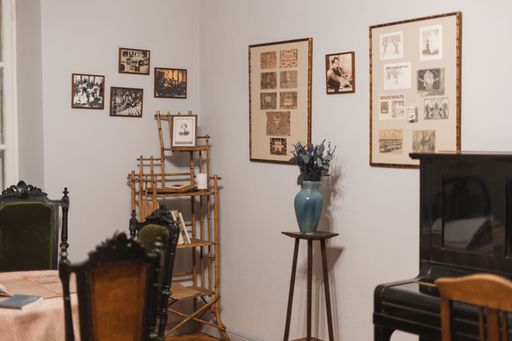
11 Savičiaus str. (at that time the house number was 6) November 1907 - June 1908 M. K. Čiurlionis rented a room where he lived and worked. During his stay in Vilnius, he was elected vice-chairman of the Lithuanian Art Society, and was one of the organizers of the Second Lithuanian Art Exhibition; he led the society's "Vilniaus kanklės" choir four times a week and wrote the parts for the voices; he also created his own cycle of piano landscapes called "Marė" (The Sea), and gave music lessons. M. K. Čiurlionis' future fiancée and wife, Sofija Kymantaitė, stayed in this house.
On 24 September 1995 (on the occasion of the 120th anniversary of M. K. Čiurlionis' death), the room was transformed into a memorial cultural centre, which is now known as the 'M. K. Čiurlionis House'.
More information: www.ciurlioniokelias.lt, www.mkcnamai.lt
Audio guide: https://gidas.mkcnamai.lt/en/
Author of photos: Deinora Rudėnaitė
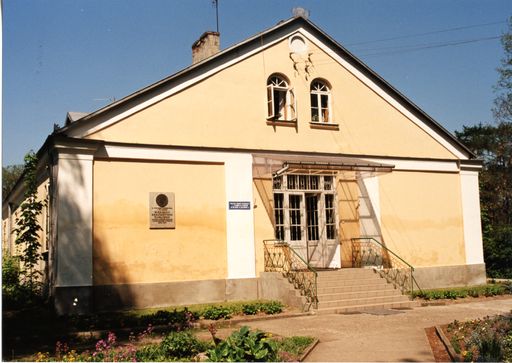
Pustelnik (now part of the Marki municipality) is an area in eastern Poland, near Warsaw. It has been connected to Warsaw since 1896 by a narrow gauge railway. It is now one of Warsaw's suburbs (it became one in 1967).
A private sanatorium, the Red Manor Sanatorium, was established in Pustelnik, where M. K. Čiurlionis was treated and spent the last moments of his life.
Pustelnik and M. K. Čiurlionis
Pustelnik was the last place where Čiurlionis lived and where he was treated for nervous exhaustion. He arrived here in February 1910. In the summer of 1910, after his health had improved somewhat, the artist was allowed to paint and play the piano. While he was being treated in the sanatorium, his only child, his daughter Danutė, was born in Lithuania. Čiurlionis wanted to see her very much, but it was not meant to be. In 1911, while out for a walk, the artist caught a cold and fell ill with pneumonia. The illness finally broke down Čiurlionis' health and he died on 28 March 1911 (10 April according to the new calendar), aged 35.
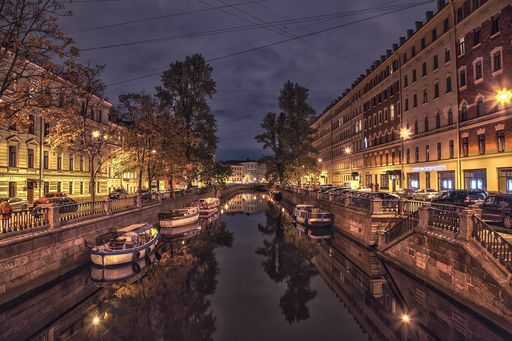
St. Petersburg was founded by Tsar Peter I of Russia after the Northern War (1700-1701), when the territory was conquered from Sweden. In 1703, Peter the Great built a fortress at the mouth of the Neva, on Rabbit Island, a harbour, a stock exchange and the Admiralty and other strategically important buildings on the left bank of the Neva. St Petersburg became the capital of the Russian Empire in 1712-1728 and from 1732 to 1918.
Although the city initially developed more as an industrial centre (manufactories, factories, plants), from the 18th century onwards it became better known for its lively cultural life. The first Russian museum was founded in 1714, the Academy of Sciences in 1721 and the Academy of Fine Arts in 1757. Cultural life was particularly intense in the second half of the 19th and the beginning of the 20th century. Dostoyevsky's novels and Tchaikovsky's melodies were born here. The city now has 43 higher education institutions, 16 professional theatres, large libraries and 43 museums, the most famous of which is the Hermitage.
The city is also important politically, as it was here that the revolution of 1905-07, which swept across the Russian Empire (and thus also affected Poland and Lithuania), began. In 1917, the February Revolution and the October Coup took place here.
M. K. Čiurlionis and St. Petersburg
Čiurlionis spends the autumn months of 1908 and January - March in 1909 in St Petersburg, where he participates in exhibitions and directs the St Petersburg Lithuanian choir. The artist, following the advice of the painter Lev Antokolsky, arrives in St Petersburg hoping for a more stable income and to make a name for himself as an artist.
While living there, Čiurlionis visited M. K. Dobuzhinsky, who helped him join the Russian Artists' Union. It was difficult to make a living in St Petersburg: Čiurlionis was constantly short of money and tried to survive by giving private lessons. At the meetings of the Russian Artists' Union, the artist would play his works and show his new paintings. On the basis of the Union, he came up with the idea of establishing a Music Section at the Lithuanian Art Society.
Corresponding with Sofija Kymantaitė, he wrote music for the opera "Jūratė", planned stage curtains and scenery, and drew sketches of them. He left St Petersburg to marry Sofija, and in 1909 they both returned to St Petersburg. In the new year, Čiurlionis fared a little better: his works were exhibited at the Salon exhibition, the sixth exhibition of the Russian Artists' Union. The most demanding and the largest of Čiurlionis' works, Rex, was painted in St Petersburg. The artist did not forget music: he played his works at the concert of the "Evenings of Contemporary Music" on 28 January 1909 (10 February in the New Calendar).
In December 1909, as a result of his constant intensive work and constant deprivation, Čiurlionis finally became overworked and suffered from nervous exhaustion. The couple go to Lithuania to rest.

Istebna is a small town with a beautiful mountainous landscape in Silesia (present-day Poland). The first mention of the place name dates back to the late 16th century. At that time, it was part of the Kingdom of Bohemia, which was part of the Habsburg monarchy. In the Middle Ages, the inhabitants of the town were obligated to make tiles and prepare wood for transport along the Olza River that flows through the town. Over time, the town became a tourist centre due to its beautiful scenery.
Until the First World War, Istebna belonged to the Austro-Hungarian Empire and only in 1920 became a part of Poland.
Istebna and M. K. Čiurlionis
In 1906, the Warsaw School of Fine Arts organised a plein-air workshop in Istebna, which was attended by M. K. Čiurlionis.
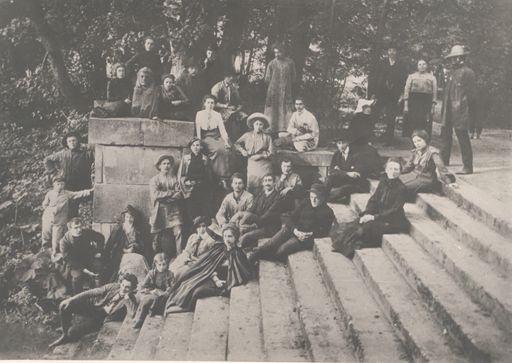
Founded by the Radvilos (Elena Radviliene-Pszezdecka and Mykolas Jernonim Radvila) around 1778, Arcadia Park was considered to be one of the most famous English parks in the whole Europe. The spectacular park (near Niebrow, in the Lodz Voivodeship of present-day Poland), with its ancient architecture (including the Temple of Diana, designed by the architect Simon Bogumil Zug) and sculptures, artificial canal and Roman aqueduct with cascades above the valley to supply water, and an amphitheatre by the architect Henryk Ithar, was stunning. At the beginning of the 20th century, the park was neglected, but it still had a romantic look.
Arcadia and M. K. Čiurlionis
In 1904, M.K. Čiurlionis took part in a plein-air workshop organised by the Warsaw School of Fine Arts in Arcadia Park, and in the evenings he played in the Temple of Diana.
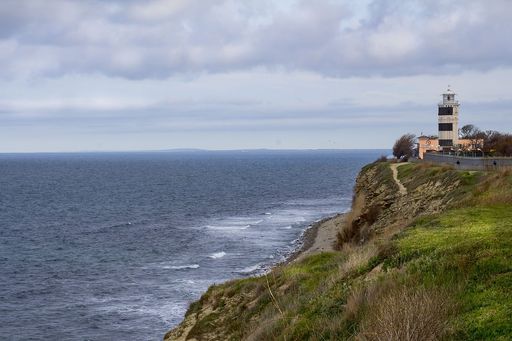
The famous resort of Anapa is located on the northern coast of the Black Sea, near the Sea of Azov. The town has long been famous for its sanatoriums and recreational areas and was one of the most popular resorts during the Russian Empire. However, Anapa continues to attract visitors with its sunny summer climate and stunning views of the sea and mountain scenery.
Anapa only got its name in the late 18th century, when the Russians arrived (the area was then part of the Ottoman Empire): from the Adyghe language, the name meant "end of the table". It was finally ceded to Russia in 1829 and became a resort in 1866.
Anapa and M. K. Čiurlionis
In 1905, M.K. Čiurlionis spent two months of summer enjoying the spectacular views and pleasant climate of Anapa, together with the Wolman family and E. Morawski. In Anapa, Čiurlionis painted, took photographs (39 of which he later glued together in the album "Anapa. 1905". After gaining inspiration there, he also later painted the paintings "The Shore" (1905), "Cliff by the Sea" (1905), "Cliff at the Seaside" (1905), "Seashore" (1905) and "The Mountain" (1906).
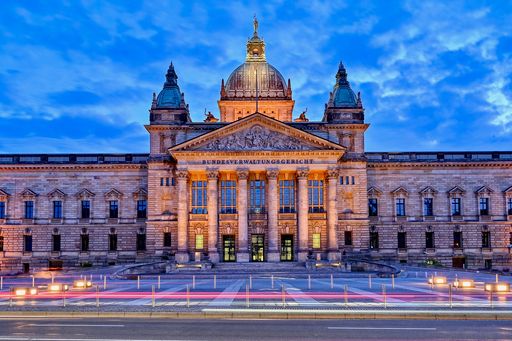
Leipzig is the largest city in Saxony, in eastern Germany. The city grew strongly thanks to trade, as it was a point on the trade routes of the Holy Roman Empire. However, the city became more known for its culture: university, conservatory, printing.
Already in the 15th century, the city was already famous for its university, founded in 1409 and one of the oldest in Europe. In the 18th century, Leipzig was known as the centre of German book printing, which led to the rapid development of the printing industry. It was here that classical German literature developed, and the university had students such as J.W. Goethe, R. Schumann, J.S. Bach, F. Nietzsche and R. Wagner.
The city is perhaps best known for the oldest conservatory in Germany, founded in 1843 by composer F. Mendelssohn. Since its foundation, the Royal Conservatory of Music in Leipzig has attracted students from all over Europe. Musical students have given concerts here, and gone to concert halls to hear famous composers such as Schumann, Bach and Wagner.
Leipzig and M. K. Čiurlionis
In 1901-1902, M. K. Čiurlionis studied at the famous Leipzig Conservatory in Prof. K. Reinecke's composition and S. Jadassohn's counterpoint classes. He also attended lectures on aesthetics, history and psychology as a free listener. In his spare time, he regularly visited the Gewandhaus and the Leipzig theatre, listening to his favourite composers. He also took the opportunity to work in his spare time: he would spend time in the library of the C.F. Peters publishing house, studying the instrumentations he liked (e.g. by R. Strauss).
While in Leipzig, he composed music: the symphonic overture Kęstutis, canons, fugues, including the Sanctus and Kyrie for mixed choir. On 14 July 1902, he received a teacher certificate from the Leipzig Conservatory.
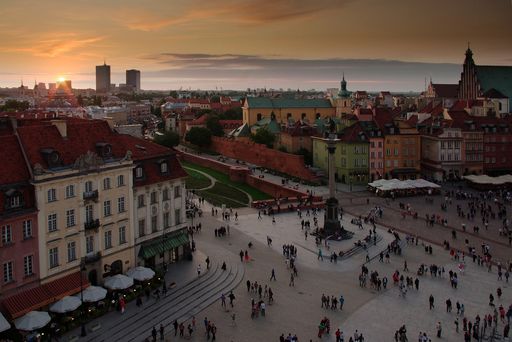
Warsaw is located in central Poland, on the Vistula River. It began to expand particularly rapidly in the 15th century, when trade intensified. Thanks to its convenient geographical location (Warsaw is almost halfway between Vilnius and Kraków), the city became the main meeting place of the Parliament of the Polish-Lithuanian Commonwealth from 1569. At the end of the 16th century, Warsaw became the main residence of the rulers of the Polish and Lithuanian States and in 1611 it officially became the capital of the Polish-Lithuanian Commonwealth.
Since the 18th century, after the reconstruction of Warsaw following the wars of the 17th century, the city has become an important centre of Polish politics, economy, culture and science. Cultural activity ceased after the uprising of 1830-1831, when the university was closed and patriotic cultural activities were banned. The city began to grow after the construction of the railway (Warsaw - St Petersburg, 1862), and patriotic demonstrations began again as people flooded into the city. After the suppression of the 1863 uprising, Warsaw began to be russified, but the Poles did not give up their patriotic ideas: societies were formed and student debates were held. This culminated in the 1905-07 Russian Revolution in Poland, after which Polish schools and societies were allowed to operate again. They did not miss the opportunity to orient their cultural life towards independence (which later led some intellectuals to flee Poland), and thus strongly encouraged patriotic creativity.
Warsaw and M. K. Čiurlionis
After graduating from the Mykolas Oginskis Plungė School of Music and working as a flutist in an orchestra, M. K. Čiurlionis came to Warsaw in 1894 to further study music. Here he enrolled in a piano class, first with T. Brzezicki, then (1895) transferred to the class of Antoni Sygietinski and studied composition with Zygmunt Noskowski. At the Warsaw Institute of Music, he met Eugeniusz Morawski, who later became a famous Polish composer. The Lithuanian fell in love with his friend's sister (Maria), but the love was prevented by her father, who hastily married off his daughter.
In 1899, after graduating from the Warsaw Institute of Music, he wrote a cantata for mixed choir and symphony orchestra, De Profundis. Čiurlionis obtained a diploma in composition. After graduating, he did not leave Warsaw: he gave private lessons and looked after his brother Povilas, who has entered the Music Institute. Because of his experience, he was offered the position of director of the Lublin Music Society's choir orchestra, but he declined. He continued to compose musical works, including his famous symphonic poem 'In the Woods', which won a special jury commendation at a competition organised by Count Zamoyski.
He left Warsaw in 1901, but returned in the autumn of 1902, as he decided to follow a different career path and become a painter. In Warsaw, he enrolled at the J. Kauzik School of Drawing. At the same time, he gave private music lessons and supported himself and his brothers, who stayed with him. He was offered a teaching position at the Warsaw Music Institute, but when he decided to draw, he declined Mlynarski's offer.
1904m. M. K. Čiurlionis started studying at the Warsaw School of Fine Arts under K. Stabrauskas. He studied with K. Tichy, K. Krzyzanowski, K. Dunikowski, F. Ruszczyca. He also directed the school choir, creating covers for books and paintings. The school also hosted the first closed exhibition of his pupils, where the Lithuanian participated with 19 works (including the lost "Storm" series). In 1905, Čiurlionis exhibited 64 paintings, including the 10-picture cycle "Fantasia" and the 5-picture cycle "Deluge". In the autumn of 1905, Čiurlionis began to direct the choir of the Warsaw Lithuanian Self-Help Society. At the end of 1906, Čiurlionis joined the choir. In 1907, in the second half of 1905, Čiurlionis stopped attending the Warsaw Art School and moved to Vilnius. He never returned to Warsaw.

Kuliai is a small town in Samogitia, only about 17 kilometres from Plungė. The settlement itself has been mentioned since the 13th century, in the 18th century it belonged to the Jesuits, and at the beginning of the 20th century the town was taken care of by the Oginskis family (who also owned nearby Plunge and Rietavas).
Around 1900, Mykolas Oginskis, together with the inhabitants of the town and the efforts of the pastor of Kuliai, V. Jarulaitis (the uncle of Sofija Kymantaitė, the future wife of M. K. Čiurlionis), erected a new brick church. In 1898-1901, the writer and priest Juozas Tumas Vaižgantas, who was very concerned about national revival and the distribution of banned books in Samogitia and Aukštaitija, served as a vicar of this church. Jurgis Gudas and Kazimieras Šleivys also distributed forbidden books in Kuliai. Juozas Tumas-Vaižgantas managed to involve Duke M. Oginskis in this cultured, but then forbidden activity.
At the beginning of the 20th century, this small Samogitian town became a centre of national and cultural revival. It was in this town that Sofija Kymantaitė, the future wife of M. K. Čiurlionis, lived.
Kuliai and M. K. Čiurlionis
Čiurlionis himself did not visit Kuliai for a long time, but he felt the influence of Kuliai through his wife Sofija Kymantaitė, who lived there for a long time (1893-1904) and who was passionate about the ideas of Lithuania. Sofija's parents moved to Kuļi in 1893, when Vincentas Jarulaitis (Sofija's uncle) offered the Kymantai family to move from Joniškis and help look after the parsonage farm. Here, Sofija began her studies and, after meeting Juozas Tumas Vaižgantas, began to work diligently on the intricacies of the Lithuanian language and to spread its importance to other countrymen.
To commemorate the time of this important personality in Kuliai, the Sofija Festival has been organised since 2017, during which sculptures are created, works are written, and concerts are held.
In 1909, M.K. Čiurlionis also visited Kuliai with Sofija: the newlyweds visited Sofija's parents.
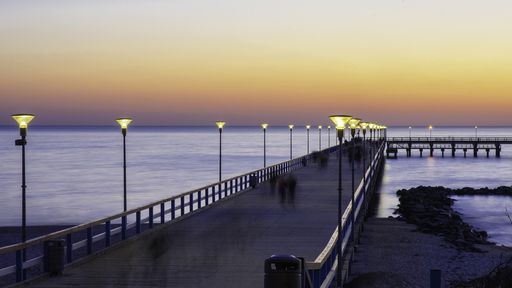
The seaside resort town of Palanga became a tourist attraction quite late - only in the 19th century. Until then, it was a trading centre dominated by the Scandinavians: Palanga itself was also mentioned for the first time in a Danish chronicle in 1161. As Palanga area was strategically important (near the sea, between the lands of the Livonian and Teutonic Orders), there were frequent skirmishes and the land suffered. After the expulsion of the Teutonic Knights from Lithuania in the 15th century, the port of Palanga recovered strongly and began to expand.
At the end of the 17th century, therapeutic bathing in Palanga began to be mentioned, and the town began to grow in popularity as a summer holiday destination. In 1824, Palanga is bought by Count Mykolas Juozapas Tiškevičius, who starts to renovate the town. Under his supervision, the famous Palanga Pier, the new palace (now the Palanga Amber Museum) and the famous park (designed by architect E. Andre) are built. In 1888, Palanga was officially recognised as a health resort, and in 1899, the first Lithuanian play was staged in Palanga - Keturakis's "America in the Bath".
In the late 19th and early 20th centuries, guests from Poland, France, Germany, England and other countries stayed in Palanga. (In 1886, a French-language newspaper "Le Limande" was published in Palanga for holidaymakers to diversify the life of the resort.) The majority of tourists were Poles and Jews, and there were few Lithuanian-speaking tourists.
Palanga and M. K. Čiurlionis
Čiurlionis was also inspired by the sea of Palanga: he and his fiancée Sofija Kymantaitė spent the summer of 1908 there, walking on the bridge, working, visiting each other, and planning to compose the opera "Jurate". Čiurlionis also painted his Sonata V (Sonata of the Sea), the diptych Prelude and Fugue, and the triptych Fantasy here. Palanga always remained a happy memory for the artist, as he constantly recalled this time in his letters.

In north-western Lithuania, a town with the same name as a tributary of the Babrungas River, Plungė, people have settled and called their settlement Plungė as well. Over the centuries, the town has been ruled by various noblemen: Aleknavičis, Valavičis, Karpis. In 1775, the Plungė manor was acquired by Bishop Ignas Masalskis of Vilnius, and only after the complicated turn of events was the palace bought by Prince Irenėjus Oginskis in 1873. After his father's death, his wealth was divided between his two sons: Bogdan settled in Rietavas, and the second, Mykolas Oginskis, in Plungė.
Mykolas Oginskis renovated the estate's surroundings: in 1879, he built a magnificent manor house, created a huge park where he dug several ponds, planted a lot of rare trees, and even settled pheasants. The palace hada rich library and art collections, and culture was of paramount importance to its owner. Like Irenėjeus Oginski, his brother Michael Oginski had also established a music school with an orchestra of 35-50 wind instruments. It was directed by the musician Dovidovičius.
Plungė and M. K. Čiurlionis
M. K. Čiurlionis studied at the Oginski Palace in 1889-1893 and later worked in the orchestra. It was here that he composed his first musical works. However, his connection with Plunge did not end there. The town was the home of Sofija Kymantaitė's uncle, who, while working as a parish priest, later married the famous artist to his wife, a writer. After the wedding (1909), the newlyweds stayed in Plunge, where they both worked and enjoyed a fresh family life.
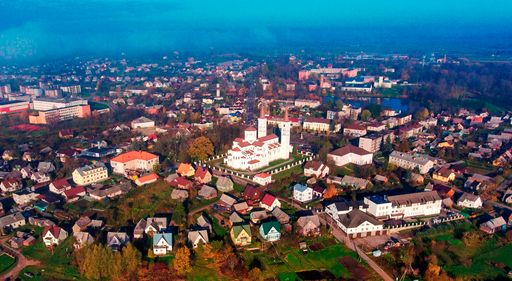
Rietavas, the town where M. K. Čiurlionis used to come to give concerts with the Mykolas Oginskis Orchestra, is located in a beautiful natural haven by the Jūra river. The town has been mentioned since 1253, but it was only after Irenėjus Oginskis, the son of Mykolas Kleopas Oginskis, took over the management of the town that an active cultural life began here. He was a strong supporter of the ideas of the 1831 uprising, but after the failure of the uprising, he devoted himself to the creation of the town and the manor. After the death of the Duke, Rietavas passed to his son Bogdan, who diligently continued the traditions of his predecessors - he was the first in Lithuania to install electric light and a telephone in Rietavas, and to build lines between Rietavas-Plungė and Rietavas-Salantai. Around 1872, B. Oginskis established a music school in Rietavas, which was headed by J. Kalvaitis, a Lithuanian musician who had graduated from the Warsaw Music Institute. In 1883, a symphony orchestra of 60 musicians was organised here, with the Czech J. Mašek invited to lead it. During various festivals, M. K. Čiurlionis and his orchestra from Plungė would come to perform at Rietavas Manor.
Rietavas and M. K. Čiurlionis
History reminds us that the music schools and orchestras founded by Bogdan Oginski (Rietavas) and his brother Mykolas Oginski (Plungė) had close ties.
They exchanged musical literature, music collections, organised joint rehearsals, and joint concerts were held during various festivals in Rietavas, Plungė, at the foot of the Gandinga and Skroblė hillforts, and at other memorable locations. It is understandable that M. K. Čiurlionis, who started studying at the Plungė School of Music in 1889, soon joined in these impressive musical events.
In Rietavas, musicians were particularly fond of performing in the Musicians' Terrace, located south-east of the palace, above the icehouse basement. From here, they had fabulous views not only of the silhouettes of the residence's towers and the arcades of the orangeries, but also of the parterre's flower gardens, the Lily Pond, and the banks of the Jaujupis River, which were festooned with flowering bushes. To the south-west, beyond the Mill Pond, was the panorama of Rietavas town with its glittering church towers.
Authentic memoirs of Vytautas Lukauskas, a musician of the Oginskis Orchestra, about M. K. Čiurlionis' visit to Rietavas with the Plunge Orchestra, and at the same time the first recognition of his work, are described by the local historian Eleonora Ravickienė in her book "Šimtmečių takais" ("Trails of the Centuries", 1992, page 85):
"(...).That day was a thunderstorm, thunder rumbled in the distance. The scent of flowers in the park was intoxicating. Musicians from Rietavas and Plungė gathered on the square near the Musicians' Terrace. The Plungė residents were very tired, as they had left Plungė early in the morning in several carts. Both orchestras were preparing for a concert at Rietavas Palace. The performance was not a success. Even M. K. Oginski's polonaise "Farewell to the Fatherland" failed. During this rehearsal, Jozef Mašek, who was conducting the Rietavas Orchestra, saw the musicians shattered and tired and announced a break. Then P. Dovydavičius, the leader of the Plungė Orchestra, handed Mašek a bundle of pipes and told him that they were pieces by M. K. Čiurlionis, a musician from Plungė, and asked him to take a look. "We played badly today with Haydn and Mozart, even Oginsky's polonaise was not successful, so it's not worth looking anywhere else", said an exasperated J. Mašek. After the break, the musicians were more invigorated and played better. Mr Mašek was also relieved. He got into M.K. Čiurlionis's pieces. The author was invited to perform. A young man stood up. Confused, with a flute in his hands. There was applause. Čiurlionis was even more confused. This was the composer's first close acquaintance with Mašek and his first musical debut.
Later, the orchestra leaders chose one piece and dedicated it to the honour of Mykolas Oginskis. It was played in the hall of Plungė Palace. It was a surprise for the Duke himself, who was very proud of his orchestra. The modest young composer was praised by the Oginski family from Austria. Encouraged by the success, the orchestra directors added several of Čiurlionis's works to their repertoire. Later, they were repeatedly performed in joint concerts of the Rietavas and Plungė orchestras.(...)".
The Easter celebrations of 17 April 1892 were held at St. Michael the Archangel Church. On that occasion, with the accompaniment of the church choir and the Oginski brothers' orchestras, the was a historic event: a hundred-bulb electric chandelier - shone for the first time beneath the vaults of the church supporting the sky. The first public power plant in Lithuania began operating in Rietavas.
Legend has it that the farewell concerts of the two orchestras in Rietavas were also held on one of the islands of the Malūnas Pond. It is not for nothing that it was named Musicians' Island. The other three islands of the Mill Pond have been renamed the Serenity, Altar and Evening islands at the suggestion of the Rietavas museum staff. All of them form a common group of M. K. Čiurlionis islands. V. Lukauskas said that at the end of the concerts, two bonfires were lit in the evening at the foot of the mound-like Ramybės Island. After the last chords of the polonaise "Farewell to the Homeland" melody had melted away, their shimmering reflections would float for a long time towards the eastern side of the Red Gate alley embankment. Here, along with other musicians, the future genius of our nation, Mikalojus Konstantinas Čiurlionis, used to rhyme. Who can deny that it was not the silhouettes of the islands of the Mill Pond and the high western shores of the Dukes Oginskis' residence in Rietavas that were immortalised in his painting "Serenity".
The romanticised times of M. K. Čiurlionis' stay in Rietavas are recalled by the name oak tree of M. K. Čiurlionis and the name lime tree of Sofija Kymantaitė-Čiurlionienė planted on Musicians' Island in 2005. A path leading to them from the Red Gate Avenue leads to Bogdan Oginskis' musicians' quay, which is decorated with the namesake oak trees of the fourteen most famous leaders and musicians of the Rietavas Historical Orchestra.
Taking into account the unique perspectives of the National M. K. Čiurlionis Cultural Route in terms of education, culture dissemination, as well as inter-regional cooperation, Rietavas Municipality has been actively involved in the implementation of the M. K. Čiurlionis 150th Birth Anniversary Programme since 2018. Older residents of Rietavas have not yet forgotten how the 100th anniversary of the birth of the genius of our nation was celebrated in Rietavas in 1975. All the thematic events were crowned by a concert by the Lithuanian Music Teachers' Choir and Symphony Orchestra conducted by Lionginas Abarius. We have no doubt that the 150th anniversary of the birth of M. K. Čiurlionis will leave a vivid record in the annals of Rietavas cultural history.
Information prepared by the staff of the Rietavas Oginskis Cultural History Museum
2018 -2024.
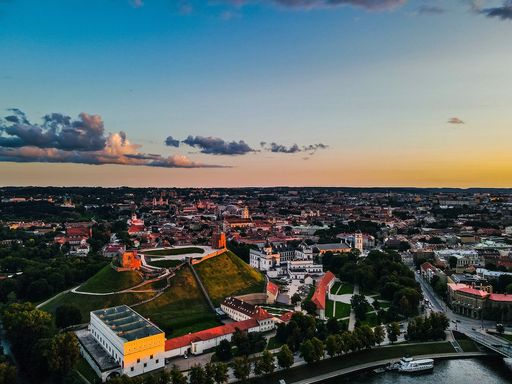
Although the current capital of Lithuania, Vilnius, dates back to the Stone Age, the city's main development dates back to the 14th century, when the Grand Duke of Lithuania, Gediminas, sent letters inviting craftsmen and merchants to the new centre of the country, Vilnius. From the very beginning, the central city of the Duchy was multiethnic, with Lithuanians, Belarusians, Germans, Tatars, Jews and Poles.
After Vilnius was baptised in 1387 and granted Magdeburg rights, the city grew and attracted new inhabitants. The famous Lithuanian noble families - the Radvilos, Chodkiewiczs and Sapiegos - built magnificent palaces here, where an active cultural life took place. The Jesuits, who arrived in Vilnius in 1579, founded the first higher education institution here - Vilnius University, which brought the public theatre to Lithuania. Cultural life continued even under the oppression of the Russian Empire, with Lithuanian societies organising art exhibitions and plays. In the late 19th and early 20th centuries, Vilnius became the centre of Lithuania's national revival, political and cultural life.
Vilnius and M. K. Čiurlionis
Čiurlionis's association with Vilnius began in 1906, when he wrote in a letter to his brother Povilas that he has decided to "dedicate all his past and future works to Lithuania". Together with Petras Rimša and Antanas Žmuidzinavičius, he organised the First Lithuanian Art Exhibition at the end of 1906, to which he sent 33 of his works. In 1907, Čiurlionis moved to Vilnius and became actively involved in the cultural life of Vilnius. Here he trained choir singers, joined discussions on the creation of the "People's Palace", painted, composed music, organised the 2nd and 3rd Lithuanian art exhibitions, and met his future wife, Sofija Kymantaitė.
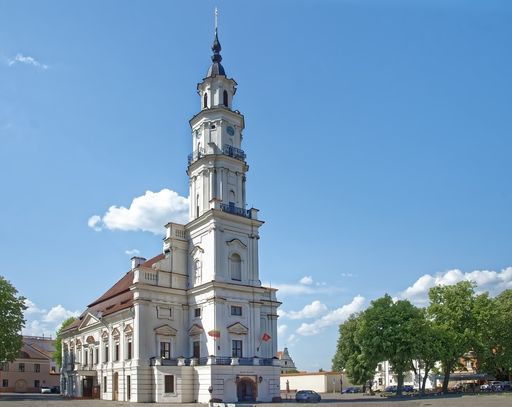
Kaunas, the second largest city in Lithuania, located at the confluence of the Nemunas and Neris rivers, was first mentioned in 1361 in the chronicle of the Teutonic Knights' herald Vygandas Marburgietis. In 1408, Vytautas Magnus granted Kaunas Magdeburg rights. Trade developed rapidly in Kaunas, especially after the establishment of the Hanseatic League in 1441. The development slowed down only in the 17th century, when the Grand Duchy of Lithuania was involved in wars with Russia, Sweden and Turkey.
After the division of the Polish-Lithuania Commonwealth (1795), the city was incorporated into the Russian Empire. In 1843 Kaunas became the centre of a governorate, and in 1862 the railway was built and the city began to grow rapidly. Cultural life also recovered: a theatre was founded in 1892 and the city museum in 1898.
Kaunas expanded most during the inter-war years (1920-1939), when it became the temporary capital of Lithuania. During these years, Kaunas became the centre of science, industry, culture and education in Lithuania. Development and cultural life came to a standstill with the Soviet occupation after World War II, when Kaunas was transformed into an industrial city. With the start of the Renaissance and the regaining of Lithuanian independence, Kaunas is shaping itself as a technologically sophisticated city of modern culture.
Kaunas and M. K. Čiurlionis
Although M. K. Čiurlionis stayed in Kaunas for a very short period of time (he came during the Second Lithuanian Art Exhibition), it is in this city that the majority of the artist's legacy is kept. In the inter-war period, due to the situation in Vilnius (which was part of Poland), when Kaunas became the temporary capital, it was here that the Čiurlionis Gallery was established, which evolved into the M. K. Čiurlionis National Art Museum.

The town is closely linked to the village of Old Varena, a little to the north. The settlement began to develop rapidly in 1862, when the St Petersburg - Warsaw railway was built. The growing population gave the name Varėna II to the town.
The town was particularly important during the Polish occupation (1920-1939). The Lithuanian-Polish demarcation line along the Merkys river separated Varėna I (Old Varėna) and Varėna II (on the Polish side) and was the subject of fierce fighting. In 1939, Varėna II was finally returned to Lithuania and became the temporary centre of the county. The town was particularly hard hit during World War II. After the end of the war, Varėna became the centre of the county in 1946, and later (1950) the centre of the district, and its population started to grow again. In 1980 Varėna I was annexed to the town. In 1994, the separated Old Varėna acquired the status of a village. Today Varėna is the centre of Varėna District Municipality and the centre of the district.
Varėna and M. K. Čiurlionis
The St. Petersburg-Warsaw railway in Varėna transported Čiurlionis to his place of study (Warsaw), Vilnius and St. Petersburg. However, the area is also important for its legends, which remind us of the environment in which Čiurlionis grew up.

Old Varėna is a small, old and romantically picturesque town located next to the Merkys river in south-eastern Lithuania. The name of the town derives from the Varėnė river (flowing through the town), from the legend of the goddess Varėnė (the patron goddess of fishermen), from the word "varo"(herd animals), because the serfs of the former manor used to herd the animals (they became herders - "varovai"). Nowadays, the town can boast of being the baptismal site of Mikalojus Konstantinas Čiurlionis.
The place was first mentioned in 1413 in a letter from Grand Duke Vytautas of Lithuania to the Master of the Teutonic Knights as a new hunting estate. The place has a greater connection with the treasurer of the GDL, Mykolas Bžostovskis, who was the governor of the Varėna municipality. He also founded the first church built in Old Varena around 1776. The town began to decline somewhat in the middle of the 17th century, when there were constant wars between the Polish-Lithuania Commonwealth and its neighbors (Russia, Sweden, Turkey). The St Petersburg-Warsaw railway on the other side of the Merkys river and the town of Varėna II (now Varėna), which started to develop around it, also contributed to the decline. The fire of 1881 and World War I also contributed to the decline of Old Varėna. In 1980, Old Varėna was annexed to Varėna and received the name Varėna Old Town. In 1994, Old Varėna became a separate village.
Old Varėna and M. K. Čiurlionis
In 1874, Konstantinas Čiurlionis and his wife Adele came to Senoji Varėna from Liškiava to work as organists. In the autumn of the following year (22 September 1875 (10 according to the old calendar)) their first son was born. The first child was born in St. On 1 October, he was baptised Mikalojus Konstantinas by the priest Aloyzas Giaras of the Archangel Michael Church.

The 6-room apartment in the building at 2 Pylimo Street belonged to the Lithuanian Artist Society and was used as the second headquarters/exhibition hall. From 20 October 1913 (2 November in the new calendar) until 1 November 1914 (14 November in the new calendar), a permanent exhibition of M. K. Čiurlionis works was held intermittently. The first headquarters of the Lithuanian Art Society was located in an apartment at 9 Liejyklos Street, owned by dentist Sofija Gimbutaitė.
More information: www.ciurlioniokelias.lt

In 1908 (12 March - 11 May (28 February - 28 April in the old calendar)) the Second Exhibition of Lithuanian Art was held in the building at Pylmo Street 6, where M. K. Čiurlionis, who was then the vice-chairman of the Lithuanian Art Society, exhibited about 60 of his works. For this exhibition, Čiurlionis also selected the exhibits of the professional art and carried out other administrative activities.
More information: www.ciurlioniokelias.lt

The only Lithuanian services in Vilnius were held in the auxiliary buildings of St. Nicholas Church (formerly Nikolajevskaja 6). This was also the place for the activities of several Lithuanian associations. It is probable that M. K. Čiurlionis and the choir he directed used to rehearse here.
More information: www.ciurlioniokelias.lt

In 1907-1911, the headquarters of the Lithuanian Art Society was registered at this address. The apartment belonged to the dentist Sofija Gimbutaitė, and M. K. Čiurlionis stayed here in the autumn of 1907, when he was substituting the chairman of the Society, A. Žmuidzinavičius who was away at the time. Later, he moved to a rented room in Savičiaus Street (now M. K. Čiurlionis House).
More information: www.ciurlioniokelias.lt

In April-June 1909, the palace hosted the Third Exhibition of Lithuanian Art, where over 30 paintings by M. K. Čiurlionis were exhibited. The premises of the palace were rented by the Lithuanian Art Society, but M. K. Čiurlionis did not participate in the exhibition, as he was in St. Petersburg at the time.
More information: www.ciurlioniokelias.lt

In February 1906, a Lithuanian bookstore headed by Marija Piaseckaitė-Šlapelienė opened in a building of Renaissance, Classicist and Historicist architectural styles (formerly located at 13 Blagoveščenskaja St., now Dominikonų st. 11). The owner of the bookshop, the first female bookseller, was the first performer of the first Lithuanian opera "Birutė", and also attended the "Vilnius Kanklės" choir led by M. K. Čiurlionis, so it is assumed that M. K. Čiurlionis himself also has visited this bookshop at some point.
More information: www.ciurlioniokelias.lt

The Lithuanian Mutual Benefit Society moved some of its activities to a house on the corner of Lydos 6 and Pranciškonų 3 (formerly Lydos St. 7). The members of the Benefit Society moved out of the parsonage of St. Nicholas Church (end of 1908). It is possible that some of the rehearsals of "Vilnius Kanklės" choir under the direction of M. K. Čiurlionis could have happened here, and the first Lithuanian bi-annual courses in Vilnius were held here. One of the teachers of Lithuanian language was M. K. Čiurlionis' future wife, Sofija Kymantaitė.
More information: www.ciurlioniokelias.lt
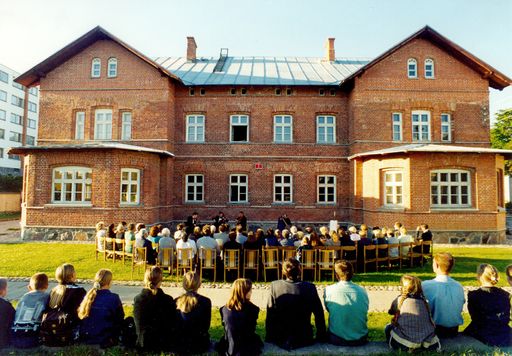
The first professional six-year music school in Lithuania operated in this building in 1872-1904, maintained by Prince Bogdan Oginski. The Plungė Mykolas Oginskis Orchestra, in which M. K. Čiurlionis played from 1889 to 1892, also visited the school.
In the interwar period, the historic music hall housed the Rietavas Gymnasium, and after World War II - a secondary school, but in 1973 the building was abandoned and eventually turned into ruins. With the beginning of the new Lithuanian Revival, this monument of cultural history was resurrected to a new life. In 2000, the Rietavas Oginskis Cultural History Museum was established here. The creative aura of M. K. Čiurlionis is recalled in the museum by thematic exhibitions and educational-musical events.

When the works of Lithuanian art could not fit into the Temporary M. K. Čiurlionies Gallery (27 Mackevičiaus St.), and visitors complained about the gallery's distant location, a new museum was opened in 1936 - the Vytautas Magnus Museum of Culture (architects: Vladimiras Dubeneckis, Kazimieras Kriščiukaitis, Karolis Reisonas). The entire collection of M. K. Čiurlionis was transferred here.
In 1944, during the second Soviet occupation, the museum was renamed the Kaunas State M. K. Čiurlionis Art Museum. In 1969, a modern M. K. Čiurlionis Gallery (architect Feliksas Vitas) was built next to the museum.
After the restoration of independence, the museum was granted national status in 1997, and in 2003 the M.K. Čiurlionis Gallery was renovated. Its permanent exposition displays most of M.K. Čiurlionis' legacy.
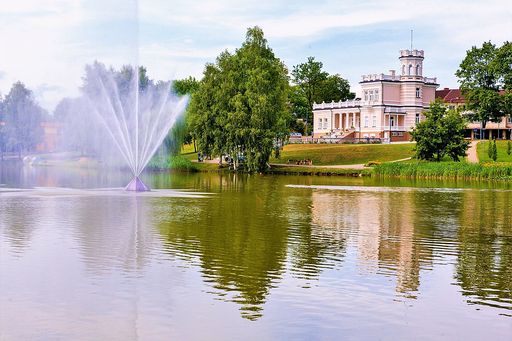
Druskininkai is located in the south of Lithuania, on the right side of the Nemunas river at a bend in the river. The town is surrounded by coniferous forests, where M. K. Čiurlionis, the artist from Lithuania, used to go for walks and daydream, and where he spent his childhood.
Druskininkai was first mentioned in written sources in 1636, but already in the 13th century the area belonged to the Grand Duchy of Lithuania with a fortress that was part of the Panemunė defensive system. The name of the town is believed to have originated from the speciality "salt worker" ("druskininkas"), and the town took this name in 1765.
Since ancient times, Druskininkai has been known for its mineral springs, which, according to legend, were found in the place where the wife of a prince shed tears when she was frightened that her husband had drowned in the Nemunas river (he emerged alive and well with a falcon from the water). On the orders of Grand Duke Stanislaw Poniatowski of Lithuania, research was carried out on the healing properties of the mineral waters and, after the results were confirmed, Druskininkai was declared a healing place in 1794. In 1837, the town was granted the status of a health resort, making it the oldest balneological, mud and climatic resort in Lithuania.
The number of resort visitors increased especially after the opening of the St Petersburg-Warsaw railway in 1862 (the nearest stop is Varėna), which made it easier for tourists to reach the spa. This paid off, with Druskininkai becoming the third most visited resort in the Russian Empire (after the Caucasus and the Crimea) in the late 19th and early 20th centuries.
Druskininkai and M. K. Čiurlionis
The first child of the Čiurlionis family attended school here, received the initial knowledge of music, and observed the surroundings (Druskininkai), which at that time were already full of health resorts, hotels, summer cottages, and people coming from Vilnius and Warsaw. Druskininkai became a very important place for M.K. Čiurlionis in his life and work.
For Čiurlionis' parents and the whole family, it was a very important tourist destination. Čiurlionis' parents owned a house which they used to rent out to people on holiday in the summer, which was a major financial contribution to the life of the family of 11.
Druskininkai can also boast of being the beginning of Čiurlionis' creative journey. In 1844-1852, the first wooden Catholic church was built in Druskininkai, where Konstantinas Čiurlionis began to play the organ in 1878, replaced on some days by his talented son, Mikalojus Konstantinas.
There is a lot of information about Čiurlionis' time in Druskininkai in J. Čiurlionytė's book "Memoirs of M. K. Čiurlionis".
 Liškiava
LiškiavaLiškiava, Lithuania  Lipliūnai
LipliūnaiLipliūnai, Lithuania  Former location of "St. Rokas"
Former location of "St. Rokas"Kaimelis, Lithuania  Duke Tiškevičius Manor Terace
Duke Tiškevičius Manor TeraceVytauto st. 17, Palanga, Lithuania  Duke Tiškevičius Palace and Park
Duke Tiškevičius Palace and ParkVytauto st. 17, Palanga, Lithuania  Stephen Sharapov's sculpture "Sagittarius" based on the works of M. K. Čiurlionis
Stephen Sharapov's sculpture "Sagittarius" based on the works of M. K. ČiurlionisBirutės park, Palanga, Lithuania  The house where Čiurlionis visited his fiancée S. Kymantaitė in 1908-1909
The house where Čiurlionis visited his fiancée S. Kymantaitė in 1908-1909L. Vaineikio st. 17, Palanga, Lithuania  The former site of the rotunda in the garden of the Palanga Kurhaus
The former site of the rotunda in the garden of the Palanga KurhausGrafų Tiškevičių ave 1, Palanga, Lithuania  Bench, Dedicated to M.K. Čiurlionis
Bench, Dedicated to M.K. ČiurlionisM. K. Čiurlionio g. 59, 66119 Druskininkai, Lithuania - 2024-04-15
 Palanga Pier
Palanga PierPalanga, Lithuania  Monument to M. K. Čiurlionis "Legend. Kings"
Monument to M. K. Čiurlionis "Legend. Kings"Parko st. 3A, Plungė, Lithuania  Site of the former pheasantry
Site of the former pheasantryParko st. 1, Plungė, Lithuania  Mykolas Oginskis Manor House
Mykolas Oginskis Manor HouseParko st. 3A, Plungė, Lithuania  Manor stables
Manor stablesParko st. 5, Plungė, Lithuania  The former Mykolas Oginskis Manor Music Hall
The former Mykolas Oginskis Manor Music HallParko st. 1, Plungė, Lithuania
